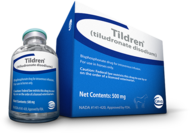
Treatment of lameness in horses
For treatment of lameness associated with bone spavin in horses older than 3 years.
VETERINARY MEDICINE
SCHEDULING STATUS:
S4
PROPRIETARY NAME (AND DOSAGE FORM):
TILDREN® (Powder for injection)
Reg. No. A04/3.1.5/08 (Act 101/1965)
COMPOSITION:
Tiludronic acid (as disodium salt) 50 mg
PHARMACOLOGICAL CLASSIFICATION:
C 3.1.5 Musculo-skeletal systems and joints – other.
PHARMACOLOGICAL ACTION:
Tiludronic acid is an active ingredient which belongs to the therapeutic class of biphosphonates whose main pharmacological property is the inhibition of bone resorption.
Pharmacokinetic properties:
The pharmacokinetic profile of Tiludronic acid (as a disodium salt) after intravenous administration to horses at a dose of 0,1 mg/kg/day is characterised by:
- A rapid decrease in plasma concentrations during the first 24 hours; after repeated administration, a steady state in plasma concentrations is reached rapidly without any notable accumulation in plasma during the treatment.
- A degree of binding to plasma proteins of about 80 % - 85 %.
- Fast and widespread distribution in the bone, the storage compartment where Tiludronic acid preferentially binds to the active remodelling sites, by binding to hydroxyapatite crystals. After a treatment with single daily injections for 10 days, the bound quantity corresponds to 30 to 50% of the total administered dose. The distribution in the bone is not uniform; binding is greater in cancellous bone than in cortical bone.
- No biotransformation.
- Elimination via the urine; after a single injection, the dose excreted via the urine over a period of 96 hours corresponds to 25 to 50 % of the administered dose. The dose excreted via the faeces corresponds to less than 1 % of the administered dose.
Pharmacodynamic properties:
Tiludronic acid exerts its inhibitory effect on bone resorption by blocking some of the osteoclasts’ metabolic pathways (production of non-hydrolysable cytotoxic ATP-analogue metabolites, inhibition of the organisation of the cytoskeleton required for the activation of the osteoclast and inhibition of the osteoclastic proton pumps). Tiludronic acid acts as a regulator of bone remodelling in all situations where excessive bone resorption is occurring.
INDICATIONS:
Treatment of lameness associated with bone spavin in horses older than 3 years old.
CONTRA-INDICATIONS:
Do not administer to horses less than 3 years old.
WARNINGS:
Tiludronic acid may complex with divalent ions.
DOSAGE AND DIRECTIONS FOR USE:
0,1 mg of Tiludronic acid per kg of body weight daily for 10 days by slow intravenous route i.e. 1 mℓ of reconstituted solution per 50 kg of body weight per day.
Major incompatibilities:
Do not mix the reconstituted solution with solutions based on divalent metal ions such as Ca2+ or Mg2+; a solution of Tiludronic acid may form complexes with these ions.
SIDE-EFFECTS AND SPECIAL PRECAUTIONS:
Side-effects:
The main adverse effects related to the treatment with Tildren are signs of colic, muscle tremor or sweating. These signs are dose-dependent; they generally appear within 2 to 3 hours after the injection and are short in duration. The signs of colic resolve spontaneously without requiring any specific treatment.
A local reaction at the injection site may appear after the intravenous injection of the medicine. This reaction is minor and resolves spontaneously within a few days.
Special precautions for use:
It is advisable to monitor the horse for the first three hours following the injection due to the possible onset of adverse reactions.
Use during pregnancy and lactation:
The safety of the medicine has not been studied in pregnant or lactating females. The use of the medicine during pregnancy or lactation in mares is not recommended.
KNOWN SIGNS OF OVERDOSAGE AND PARTICULARS OF ITS TREATMENT:
In the event of an overdose, signs of colic (possibly associated with muscle tremor, sweating or salivation) may appear within a few hours following treatment. Their intensity is moderate and they clear up spontaneously.
Classical treatments based on antispasmodics and analgesics may be given to treat the signs of colic.
IDENTIFICATION:
Freeze-dried powder: A compact freeze-dried white powder in a clear glass vial. The reconstituted solution is clear, colourless and free from visible suspended particles.
Water for Injection: A clear, colourless, odourless and tasteless liquid in a clear glass vial.
PRESENTATION:
Freeze-dried powder: 10 mℓ Type II clear glass vial with Type I grey chlorobutyl stoppers suitable for freeze-drying and aluminium over-seal with blue flip-off cap.
Water for Injection: 10 mℓ Type II colourless glass vial with Type II red-brown chlorobutyl stoppers and aluminium over-seal with flip-off green cap.
STORAGE INSTRUCTIONS:
Freeze-dried powder and Water for Injection: Store below 25 °C.
Any unused portion of the reconstituted product must be discarded.
KEEP OUT OF REACH OF CHILDREN AND UNINFORMED PERSONS.
REGISTRATION NUMBER:
C A04/3.1.5/08 (Act 101/1965)
NAME AND BUSINESS ADDRESS OF THE HOLDER OF THE CERTIFICATE OF REGISTRATION:
Ceva Animal Health (Pty) Ltd
Corner of 16th and Douglas Streets
Randjiespark
Midrand
1685
South Africa
011 312 4088

 Corporate Website
Corporate Website
 Africa
Africa
 Argentina
Argentina
 Asia
Asia
 Australia
Australia
 Belgium
Belgium
 Brazil
Brazil
 Bulgaria
Bulgaria
 Canada (EN)
Canada (EN)
 Chile
Chile
 China
China
 Colombia
Colombia
 Denmark
Denmark
 Egypt
Egypt
 France
France
 Germany
Germany
 Greece
Greece
 Hungary
Hungary
 Indonesia
Indonesia
 Italia
Italia
 India
India
 Japan
Japan
 Korea
Korea
 Malaysia
Malaysia
 Mexico
Mexico
 Middle East
Middle East
 Netherlands
Netherlands
 Peru
Peru
 Philippines
Philippines
 Poland
Poland
 Portugal
Portugal
 Romania
Romania
 Russia
Russia
 South Africa
South Africa
 Spain
Spain
 Sweden
Sweden
 Thailand
Thailand
 Tunisia
Tunisia
 Turkey
Turkey
 Ukraine
Ukraine
 United Kingdom
United Kingdom
 USA
USA
 Vietnam
Vietnam
